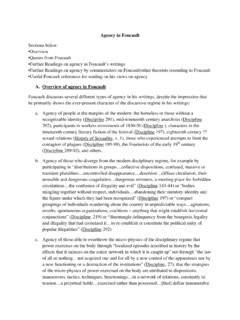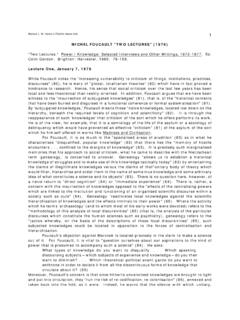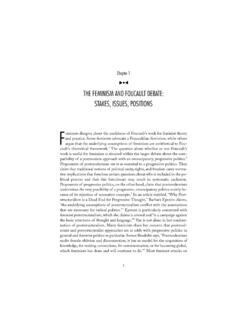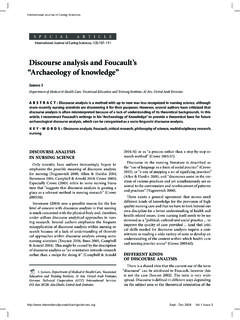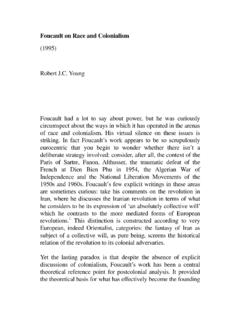Transcription of From: Architecture /Mouvement/ Continuité October, 1984;
1 From: Architecture /Mouvement/ Continuit October, 1984; ( Des Espace Autres, March 1967 Translated from the French by Jay Miskowiec) Of Other Spaces: Utopias and Heterotopias MICHEL foucault The great obsession of the nineteenth century was, as we know, history: with its themes of development and of suspension, of crisis, and cycle, themes of the ever-accumulating past, with its great preponderance of dead men and the menacing glaciation of the world. The nineteenth century found its essential mythological resources in the second principle of thermodynamics. The present epoch will perhaps be above all the epoch of space. We are in the epoch of simultaneity: we are in the epoch of juxtaposition, the epoch of the near and far, of the side-by-side, of the dispersed. We are at a moment, I believe, when our experience of the world is less that of a long life developing through time than that of a network that connects points and intersects with its own skein.
2 One could perhaps say that certain ideological conflicts animating present-day polemics oppose the pious descendents of time and the determined inhabitants of space. Structuralism, or at least which is grouped under this slightly too general name, is the effort to establish, between elements that could have been connected on a temporal axis, an ensemble of relations that makes them appear as juxtaposed, set off against one another, implicated by each other that makes them appear, in short, as a sort of configuration. Actually, structuralism does not entail denial of time; it does involve a certain manner of dealing with what we call time and what we call history. Yet it is necessary to notice that the space which today appears to form the horizon of our concerns, our theory, our systems, is not an innovation; space itself has a history in Western experience, and it is not possible to disregard the fatal intersection of time with space.
3 One could say, by way of retracing this history of space very roughly, that in the Middle Ages there was a hierarchic ensemble of places: sacred places and profane places: protected places and open, exposed places: urban places and rural places (all these concern the real life of men). In cosmological theory, there were the supercelestial places as opposed to the celestial, and the celestial place was in its turn opposed to the terrestrial place. There were places where things had been put because they had been violently displaced, and then on the contrary places where things found their natural ground and stability. It was this complete hierarchy, this opposition, this intersection of places that constituted what could very roughly be called medieval space: the space of emplacement. This space of emplacement was opened up by Galileo.
4 For the real scandal of Galileo s work lay not so much in his discovery, or rediscovery, that the earth revolved around the sun, but in his constitution of an infinite, and infinitely open space. In such a space the place of the Middle Ages turned out to be dissolved, as it were; a thing s place was no longer anything but a point in its 2 movement, just as the stability of a thing was only its movement indefinitely slowed down. In other words, starting with Galileo and the seventeenth century, extension was substituted for localization. Today the site has been substituted for extension which itself had replaced emplacement. The site is defined by relations of proximity between points or elements; formally, we can describe these relations as series, trees, or grids. Moreover, the importance of the site as a problem in contemporary technical work is well known: the storage of data or of the intermediate results of a calculation in the memory of a machine, the circulation of discrete elements with a random output (automobile traffic is a simple case, or indeed the sounds on a telephone line); the identification of marked or coded elements inside a set that may be randomly distributed, or may be arranged according to single or to multiple classifications.
5 In a still more concrete manner, the problem of siting or placement arises for mankind in terms of demography. This problem of the human site or living space is not simply that of knowing whether there will be enough space for men in the world a problem that is certainly quite important but also that of knowing what relations of propinquity, what type of storage, circulation, marking, and classification of human elements should be adopted in a given situation in order to achieve a given end. Our epoch is one in which space takes for us the form of relations among sites. In any case I believe that the anxiety of our era has to do fundamentally with space, no doubt a great deal more than with time. Time probably appears to us only as one of the various distributive operations that are possible for the elements that are spread out in space, Now, despite all the techniques for appropriating space, despite the whole network of knowledge that enables us to delimit or to formalize it, contemporary space is perhaps still not entirely desanctified (apparently unlike time, it would seem, which was detached from the sacred in the nineteenth century).
6 To be sure a certain theoretical desanctification of space (the one signaled by Galileo s work) has occurred, but we may still not have reached the point of a practical desanctification of space. And perhaps our life is still governed by a certain number of oppositions that remain inviolable, that our institutions and practices have not yet dared to break down. These are oppositions that we regard as simple givens: for example between private space and public space, between family space and social space, between cultural space and useful space, between the space of leisure and that of work. All these are still nurtured by the hidden presence of the sacred. Bachelard s monumental work and the descriptions of phenomenologists have taught us that we do not live in a homogeneous and empty space, but on the contrary in a space thoroughly imbued with quantities and perhaps thoroughly fantasmatic as well.
7 The space of our primary perception, the space of our 3 dreams and that of our passions hold within themselves qualities that seem intrinsic: there is a light, ethereal, transparent space, or again a dark, rough, encumbered space; a space from above, of summits, or on the contrary a space from below of mud; or again a space that can be flowing like sparkling water, or space that is fixed, congealed, like stone or crystal. Yet these analyses, while fundamental for reflection in our time, primarily concern internal space. I should like to speak now of external space. The space in which we live, which draws us out of ourselves, in which the erosion of our lives, our time and our history occurs, the space that claws and gnaws at us, is also, in itself, a heterogeneous space. In other words, we do not live in a kind of void, inside of which we could place individuals and things.
8 We do not live inside a void that could be colored with diverse shades of light, we live inside a set of relations that delineates sites which are irreducible to one another and absolutely not superimposable on one another. Of course one might attempt to describe these different sites by looking for the set of relations by which a given site can be defined. For example, describing the set of relations that define the sites of transportation, streets, trains (a train is an extraordinary bundle of relations because it is something through which one goes, it is also something by means of which one can go from one point to another, and then it is also something that goes by). One could describe, via the cluster of relations that allows them to be defined, the sites of temporary relaxation cafes, cinemas, beaches. Likewise one could describe, via its network of relations, the closed or semi-closed sites of rest the house, the bedroom, the bed, et cetera.
9 But among all these sites, I am interested in certain ones that have the curious property of being in relation with all the other sites, but in such a way as to suspect, neutralize, or invent the set of relations that they happen to designate, mirror, or reflect. These spaces, as it were, which are linked with all the others, which however contradict all the other sites, are of two main types. HETEROTOPIAS First there are the utopias. Utopias are sites with no real place. They are sites that have a general relation of direct or inverted analogy with the real space of Society. They present society itself in a perfected form, or else society turned upside down, but in any case these utopias are fundamentally unreal spaces. There are also, probably in every culture, in every civilization, real places places that do exist and that are formed in the very founding of society which are something like counter-sites, a kind of effectively enacted utopia in which the real sites, all the other real sites that can be found within the culture, are simultaneously represented, contested, and inverted.
10 Places of this kind are 4 outside of all places, even though it may be possible to indicate their location in reality. Because these places are absolutely different from all the sites that they reflect and speak about, I shall call them, by way of contrast to utopias, heterotopias. I believe that between utopias and these quite other sites, these heterotopias, there might be a sort of mixed, joint experience, which would be the mirror. The mirror is, after all, a utopia, since it is a placeless place. In the mirror, I see myself there where I am not, in an unreal, virtual space that opens up behind the surface; I am over there, there where I am not, a sort of shadow that gives my own visibility to myself, that enables me to see myself there where I am absent: such is the utopia of the mirror. But it is also a heterotopia in so far as the mirror does exist in reality, where it exerts a sort of counteraction on the position that I occupy.











